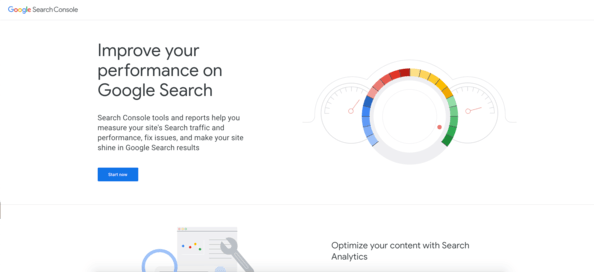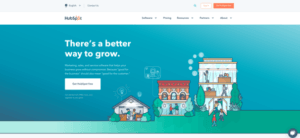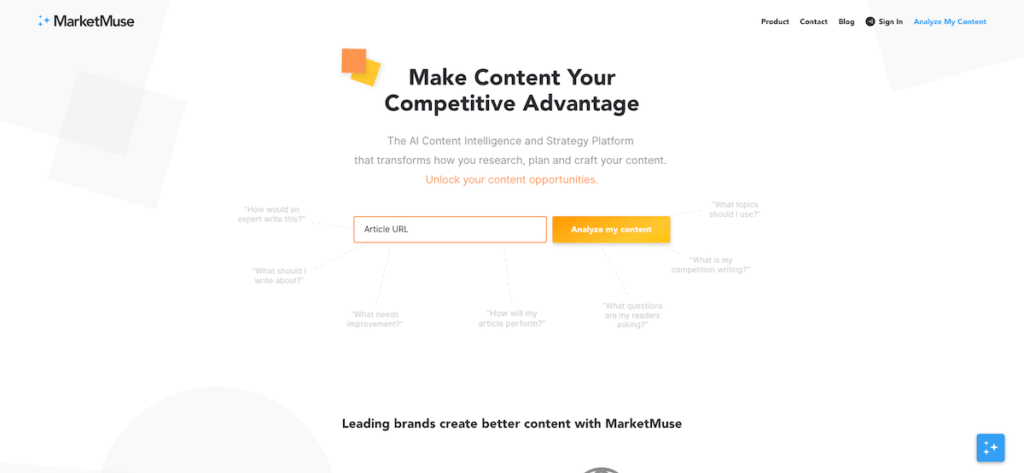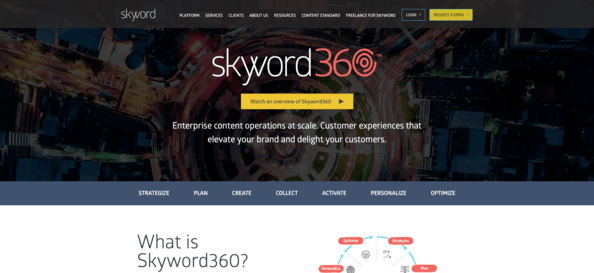Website Optimization Software and Tools for Content Marketers (10 You Must Have)
Remember those Tamagotchi pets that were really popular in the late 90s? They needed constant care and attention, or they would die?
You can think of your website as a kind of Tamagotchi. Your site should be working for you, attracting prospective customers pulling them down the sales funnel and converting them to paying and repeat customers.
To do that, it needs constant attention to improve SEO and CRO, to ensure your content is meeting user intent in the best way possible, and to make sure site speed is optimized.
And there are tools that can help you track and improve all of those metrics. We’ve put together 10 of our favorite optimization tools and how they can help your website rank and bring in customers.
We’ve broken them up into four categories: search engine optimization, conversion rate optimization, keyword and content optimization, and site speed optimization tools.
Search Engine Optimization Software
There are two kinds of search engine optimization (SEO). There’s front-end SEO, which focuses on on-page optimization of elements like the kinds of keywords you’re using, the structure of your content and the frequency and quality of your posts.
Then there’s back-end SEO, which focuses on the more technical aspects of optimizing your site for SERPs. Those include things like site map structure, robots.txt access, and backlinks.
Let’s look at a few examples of search engine optimization software that help you manage one, the other or both.
1. Google Search Console

Google Search Console (formerly known as Google Webmaster Tools) is a back-end tool that helps fix and optimize all of those very technical aspects of your site.
It’s a free tool for webmasters to check and fix site elements and offers simple rank tracking.
The search engine uses bots to crawl your site and look for technical red flags that signal a low-quality site. Those include pages that deny access to its crawlers, a sitemap that doesn’t reflect the actual structure of the site or backlinks from shady websites.
So, while you may have optimized pages with high-quality content, there may be a few out-of-sight issues that are holding down your search ranking.
On the front end, Google Search Console will also tell you the kinds of search terms that are leading people to your site so you can optimize your content to match what people are searching for.
2. Hubspot

Hubspot provides three kinds of software: marketing, sales and customer service. Their marketing software, called Marketing Hub, helps businesses track, manage and improve their SEO.
They provide a content strategy tool that helps create content around key search terms that appeal to your audience and offer SEO suggestions on your content. Plus, you can manually track topic clusters around a keyword.
Finally, you can track your content to see how its performing and use that information to plan your next content campaign.
3. SearchMetrics

This is a full-service tool that uses both its platform and a team of real people to analyze your current content for both front- and back-end SEO. That’s called their SEO Check-Up.
They’ll then make recommendations and help you come up with a plan to optimize your site and its current content offering for SEO. Next, they come up with a content strategy for creating optimized content moving forward.
After that, they’ll track your content’s performance and perform regular content updates to make sure your ranking stays where it is.
Conversion Rate Optimization Tools
Once you get people to your site, you want them to stay and take some kind of action, right? That action is called a conversion, and there are many different types.
There are micro-conversions, like signing up for a newsletter or putting something in a shopping cart, and there are macro-conversions, like buying a product or signing up for a membership.
Whatever action you want your audience to take, it’s important to have the right tools on your site to help them make that conversion. Those tools include solid microsites, landing pages and calls to action (CTAs) with the right messaging that makes it clear what a user should do.
The software listed here can help you build and optimize those tools.
1. Crazy Egg

Crazy Egg provides a host of tools to help improve your site’s conversion rate.
First, they have an array of testing and mapping tools that let you see your site as your user sees it. Heatmaps and recordings allow you to see where users are clicking. Scroll maps show you how far people are scrolling down a page before they leave.
Confetti snapshots show you a color-coded view of exactly how many people are clicking on different areas of a page. You can segment the data into metrics like geography and time on site.
You can use these tools to see if people are clicking on your CTA, or if people are reading the text on your landing page.
Finally, Crazy Egg provides A/B testing tools. Once you’ve looked at your maps and snapshots and you have a theory as to how you can fix your page, you can use the A/B testing tools to check out that theory.
Create a newer version of the page, set a time frame, and test it against the older version to see which performs better.
2. Optimizely

This tool also provides A/B testing tools. It helps you personalize messaging across CTAs, landing pages and other pages on your site for different audience segments. Then it tracks them against previous messages to determine which is resonating with your audience.
You can test everything from imagery to messaging to the number of form fields on your newsletter signup form.
3. Unbounce

Unbounce is a CRO tool with a little bit of SEO help thrown in. It lets you build custom landing pages, sticky bars, and CTAs and optimize them for your customers.
Unbounce’s tools will swap out text you’ve written for popular keywords. It will also make sure any video or image files you embed aren’t too big, which can slow down load time (more on that in a minute).
It also helps you create mobile-responsive pages, which is so important for ranking with Google.
In 2018, Google rolled out mobile-first indexing, which means it will use your mobile site to index you in its search pages first before it crawls your desktop site. So if you don’t already have a mobile-friendly website, it should be a top priority.
Keyword and Content Optimization Tools
These tools do exactly what their name suggests. They assess the keywords you use, the content you create and how the two match up. It’s no longer enough to create content and throw in a long-tail keyword.
Your content should address user intent as closely as possible. In fact, Google has dedicated an entire section of its Search Quality Evaluator Guidelines to understanding user intent and using it to determine the quality of a site’s content.
These tools will help you choose the best keywords for you to rank on. They will assess your current content for quality and help you plan new content that will help you rank. And MarketMuse, in particular, will ensure you are creating useful, meaningful content that matches user intent.
1. MarketMuse

MarketMuse is more than a content optimization tool. It will crawl your content semantically, looking for gaps and missing topic areas. It will also determine both its length and its depth of coverage and give you a score for each.
If your content is on the shorter side, or it doesn’t cover a topic as fully as it should, Google might see your content as thin. In that case, MarketMuse will give you real-time feedback on how to beef up your content in a meaningful way that will rank well on SERPs.
It will also provide secondary keywords and linking opportunities you may have missed.
You can even track your content to see how well your pieces ranks for their topic.
At the site level, you can get suggestions on how to cover each of your chosen topics with a variety of content that comes at each topic from different angles.
Finally, you can compare your content to that of your competitors on a one-to-one level to see how your content measures up.
2. Skyword

Skyword is a full-service content creation and tracking tool. If you go with the full package, you get a team of editors, writers, and content strategists that assess, plan, create and track your entire content marketing campaign.
But you can also choose the platform-only option, which gives you the planning and tracking tools you need but leaves the strategy and creation up to you.
With Skyword, you can research keywords and then build a content plan around the topics you choose, using their content calendar. You can then create content in the platform, setting standards like length, readability and keyword optimization.
Finally, you can track your content to see how it’s performing.
Page Speed Optimization Software
Page speed (or site speed) is a measurement of the amount of time it takes for your page (or site) to load.
When brands start digging into how they can optimize their site, page speed isn’t always a metric that immediately comes to mind. But it’s a very important one.
Google has factored page speed into its ranking algorithm. (Although, they do point out that it doesn’t carry as much weight as relevance.)
There are two reasons why Google and other search engines believe page speed is important. First, the longer it takes your page to load, the more unhappy your users become. According to Google, as page load time increases from one second to three seconds, the probability of bounce increases by 32%.
So how can you speed up your site? Try one of these tools.
1. Pingdom

Pingdom provides a variety of monitoring services and offers both a desktop version and mobile app for tracking on the go.
One of those services is the Pingdom website speed. It will check in 30-minute intervals how fast your site is loading.
Once you have the information, though, it will be up to you to determine how to fix your site speed problem. That’s where something like Google PageSpeed Tools comes in.
2. Google PageSpeed Tools

Google has a whole suite of tools to help you shave off seconds from your load time.
First, PageSpeed Insights will assess your loading speed and give you a score. Then, it will make suggestions to help you improve that score.
You can then use PageSpeed modules to rewrite and optimize resources on your website. This works for sites on Apache or Nginx servers.
They even have resources to keep your web team up-to-date on the latest best practices in performance.
Final Thoughts
Your website is like your pet (real or digital). It needs constant care and attention to make sure it’s performing at its best. Optimizing your website is easier using tools that help monitor your site’s performance. That way you can quickly make adjustments to ensure you’re getting your return on investment.
False
Laurie is a freelance writer, editor, and content consultant and adjunct professor at Fisher College. Her work includes the development and execution of content strategies for B2B and B2C companies, including marketing and audience research, content calendar creation, hiring and managing writers and editors, and SEO optimization. You can connect with her on Twitter or LinkedIn.